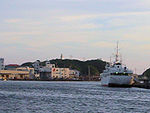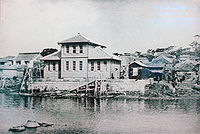
Miura, Kanagawa
Encyclopedia


Cities of Japan
||A is a local administrative unit in Japan. Cities are ranked on the same level as and , with the difference that they are not a component of...
located in central Kanagawa Prefecture
Kanagawa Prefecture
is a prefecture located in the southern Kantō region of Japan. The capital is Yokohama. Kanagawa is part of the Greater Tokyo Area.-History:The prefecture has some archaeological sites going back to the Jōmon period...
, Japan. As of 2010, the city has an estimated population
Population
A population is all the organisms that both belong to the same group or species and live in the same geographical area. The area that is used to define a sexual population is such that inter-breeding is possible between any pair within the area and more probable than cross-breeding with individuals...
of 44,238 and a population density
Population density
Population density is a measurement of population per unit area or unit volume. It is frequently applied to living organisms, and particularly to humans...
of 1,490 persons per km². The total area is 32.28 km².
Geography
Miura is located on the very southern portion of the Miura PeninsulaMiura Peninsula
is a peninsula located in Kanagawa, Japan. It lies south of Yokohama and Tokyo and divides Tokyo Bay, to the east, from Sagami Bay, to the west. Cities and towns on the Miura Peninsula include Yokosuka, Miura, Hayama, Zushi, and Kamakura....
in south-east Kanagawa Prefecture, surrounded on three sides by the Pacific Ocean
Pacific Ocean
The Pacific Ocean is the largest of the Earth's oceanic divisions. It extends from the Arctic in the north to the Southern Ocean in the south, bounded by Asia and Australia in the west, and the Americas in the east.At 165.2 million square kilometres in area, this largest division of the World...
, with Sagami Bay
Sagami Bay
Sagami Bay , also known as the Sagami Gulf or Sagami Sea, lies south of Kanagawa Prefecture in Honshū, central Japan, contained within the scope of the Miura Peninsula, in Kanagawa, to the east, the Izu Peninsula, in Shizuoka Prefecture, to the west, and the Shōnan coastline to the north, while the...
to the west. To the south of the urban area and port is the island of Jōgashima
Jōgashima
is a Japanese island of the municipality of Miura, Kanagawa Prefecture, Japan, off the southernmost and western tip of Miura Peninsula, facing Sagami Bay.It is home to the Jōgashima Lighthouse, the fourth oldest western style lighthouse to be built in Japan....
, connected to the city by a bridge. It is a popular destination for weekend tourism. The Jōgashima Lighthouse
Jōgashima Lighthouse
is a lighthouse located on the island of Jōgashima in the city of Miura, Kanagawa Prefecture, Japan, off the southernmost and western tip of Miura Peninsula, facing Sagami Bay...
was built by the French engineer Léonce Verny
Léonce Verny
François Léonce Verny, was a French officer and naval engineer who directed the construction of the Yokosuka Naval Arsenal in Japan, as well as many related modern infrastructure projects from 1865 to 1876, thus helping jump-start Japan's modernization.-Early life:Léonce Verny was born in Aubenas,...
at the end of the 19th century.
History
The area of modern Miura has been inhabited since prehistoric times. Archaeologists have uncovered numerous remains from the Japanese paleolithicJapanese Paleolithic
The began around 50,000 to 30,000 BC, when the earliest stone tool implements have been found, and continued to around 14,000 BC, at the end of the last ice age, which corresponds to the beginning of the Mesolithic Jōmon period...
, Jōmon
Jomon period
The is the time in Japanese prehistory from about 14,000 BC to 300 BC.The term jōmon means "cord-patterned" in Japanese. This refers to the pottery style characteristic of the Jōmon culture, and which has markings made using sticks with cords wrapped around them...
and Yayoi period
Yayoi period
The is an Iron Age era in the history of Japan traditionally dated 300 BC to 300 AD. It is named after the neighbourhood of Tokyo where archaeologists first uncovered artifacts and features from that era. Distinguishing characteristics of the Yayoi period include the appearance of new...
s. From the late Heian period
Heian period
The is the last division of classical Japanese history, running from 794 to 1185. The period is named after the capital city of Heian-kyō, or modern Kyōto. It is the period in Japanese history when Buddhism, Taoism and other Chinese influences were at their height...
through the end of the Sengoku period
Sengoku period
The or Warring States period in Japanese history was a time of social upheaval, political intrigue, and nearly constant military conflict that lasted roughly from the middle of the 15th century to the beginning of the 17th century. The name "Sengoku" was adopted by Japanese historians in reference...
, the area was ruled by the Miura clan
Miura clan
The ' was one of the branch families descended from the Taira clan. They held large fiefs, and great political influence. They were one of the primary opponents of the Hōjō family of regents, in the mid-13th century, and again at the beginning of the 16th...
. During the Edo period
Edo period
The , or , is a division of Japanese history which was ruled by the shoguns of the Tokugawa family, running from 1603 to 1868. The political entity of this period was the Tokugawa shogunate....
, it was tenryō territory ruled directly by the Tokugawa shogunate
Tokugawa shogunate
The Tokugawa shogunate, also known as the and the , was a feudal regime of Japan established by Tokugawa Ieyasu and ruled by the shoguns of the Tokugawa family. This period is known as the Edo period and gets its name from the capital city, Edo, which is now called Tokyo, after the name was...
. After the Meiji Restoration
Meiji Restoration
The , also known as the Meiji Ishin, Revolution, Reform or Renewal, was a chain of events that restored imperial rule to Japan in 1868...
, the town of Misaki within Miura District, Kanagawa
Miura District, Kanagawa
is an administrative district of Japan located in Kanagawa Prefecture. It currently consists of only one town, Hayama.- History :Miura District was one of the ancient subdivisions of Sagami Province, covering all of Miura Peninsula...
was created on April 1, 1889. The town was electrified in 1913, but did not have running water until 1934.
The area was badly shaken during the 1923 Great Kantō earthquake
1923 Great Kanto earthquake
The struck the Kantō plain on the Japanese main island of Honshū at 11:58:44 am JST on September 1, 1923. Varied accounts hold that the duration of the earthquake was between 4 and 10 minutes...
, which had its epicenter in Sagami Bay just a few kilometers offshore from the city. The whole geographical area around the city was lifted by about 10 meters by tectonic movement, before subsiding to its original level during the next few days. No major tsunami
Tsunami
A tsunami is a series of water waves caused by the displacement of a large volume of a body of water, typically an ocean or a large lake...
was recorded.
On January 1, 1955, Misaka merged with neighboring Minami-Shimoura town to form the city of Miura. The city was connected to the Tokyo Metropolis by rail on July 7, 1966 with the opening of Miurakaigan Station
Miurakaigan Station
is a railway station in Miura, Kanagawa, Japan, operated by Keikyu.-Lines:Miurakaigan Station is served by the Keikyū Kurihama Line, and is located 11.2 rail km from the junction at Horinouchi Station, and 63.5 rail km from the northern terminus of the Kurihama Line at Shinagawa Station, in...
on the outskirts of the city. The line was extended to Misakiguchi Station
Misakiguchi Station
is a railway station in Miura, Kanagawa, Japan, operated by Keikyu.-Lines:Misakiguchi Station is the southern terminus of the Keikyū Kurihama Line, and is located 13.4 km from Horinouchi Station, and 65.7 km from Shinagawa Station in Tokyo.-Station layout:...
on April 26, 1975, but plans to further extend the line to the city center have been abandoned.
Miura has been the arrival point of several trans-Pacific sailboat races, such as the 1969 San Francisco-Tokyo Transpacific Yacht Race
Transpacific Yacht Race
The Transpacific Yacht Race is an offshore yacht race starting off Point Fermin, San Pedro, near Los Angeles, and ending off Diamond Head Lighthouse in Honolulu, a distance of around . Started in 1906, it is one of yachting's premier offshore races and attracts entrants from all over the world...
. Misaki was also the arrival point of the record solo circumnavigation of 71 year-old Minoru Saito
Minoru Saito
Minoru Saito is a Japanese solo yachtsman. He became the oldest person at age 71 to do a solo, non-stop circumnavigation of the globe. He has successfully made seven solo circumnavigations...
, on June 6, 2005.
Economy
The economy of the city is dominated by commercial fishingCommercial fishing
Commercial fishing is the activity of catching fish and other seafood for commercial profit, mostly from wild fisheries. It provides a large quantity of food to many countries around the world, but those who practice it as an industry must often pursue fish far into the ocean under adverse conditions...
, centered around the habour of Misaki, Japan's 18th most important fishing harbor, and the 2nd for its catch of tuna
Tuna
Tuna is a salt water fish from the family Scombridae, mostly in the genus Thunnus. Tuna are fast swimmers, and some species are capable of speeds of . Unlike most fish, which have white flesh, the muscle tissue of tuna ranges from pink to dark red. The red coloration derives from myoglobin, an...
. Misaki is an important fishing harbor, mainly specializing in the processing of tuna. The harbor also has a quay which can accommodate sailboats from neighboring marinas.
Agriculture remains important to the local economy, especially watermelon
Watermelon
Watermelon is a vine-like flowering plant originally from southern Africa. Its fruit, which is also called watermelon, is a special kind referred to by botanists as a pepo, a berry which has a thick rind and fleshy center...
and daikon
Daikon
Daikon , Raphanus sativus var. longipinnatus, also called White Radish, Japanese radish, Oriental radish, Chinese radish, lo bok and Mooli , is a mild flavoured, very large, white East Asian radish...
.
Education
Miura is home to Misaki Fisheries High School, a specialist fishery high school. The school trains students in one of four commercial fisheries skills: radio communications, engineering, food processing, and ocean fishing. The school maintains two fishing vessels, one of which is the ocean-going tuna fishing ship Shōnan Maru, launched in 2005. The Shōnan Maru is a frequent visitor to the port of Honolulu as part of the training programme.Local events
Miura is well known for the Miura Marathon which is normally held in the first week of March. The race consists of three events: 5 kilometer, 10 kilometer, and a half marathonHalf marathon
A half marathon is a road running event of . It is half the distance of a marathon and usually run on roads. Participation in half marathons has grown steadily recently. One of the main reasons for this is that it is a challenging distance, but does not require the same level of training that a...
.

